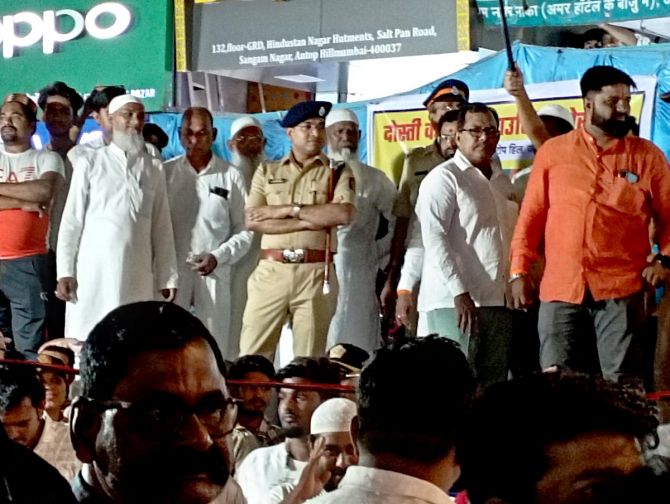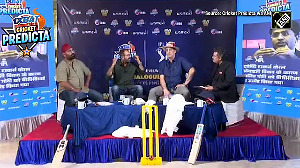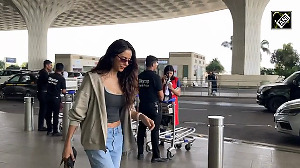Sunday's yatra proved that it needs both the maturity of locals as well as the police doing their duty, to ensure that a religious procession doesn't turn ugly, reports Jyoti Punwani.

Muslim shops were open, saffron-clad yatriS were helping Muslims make their way past and through the rally, and most surprisingly, the loud music being played along the route even before the yatra began, was switched off during the azaan that sounded just after iftaar, the breaking of the Ramzan fast.
This was the Vishwa Hindu Parishad's Ram Navami Shobha Yatra held on Sunday, April 2, 2023, evening in Sangam Nagar, Antop Hill, north central Mumbai.
"Nothing will happen, here we live in harmony. Just remind yourself of the name of our basti," smiled Sanjay Chaudhry, a Sangh Parivar member, when I asked him whether the rally would be a peaceful affair.
Dinesh Swarnkar, organiser, Bajrang Dal, Mumbai district, exuded the same confidence. "This has been an annual affair," he told this reporter later, "and we want it to continue to be one."
"We may have organised it," he explained, "but we invited all Hindu groups in the area, from young men's kreeda mandals to women's Navratri mandals, to join it, and they did. We want this larger participation of the Hindu samaj to continue. We made it clear, this is a festival; we don't want anything said from the mike that would hurt the feelings of others."

***
When Sunday's Shobha Yatra was announced by the Vishwa Hindu Parishad, it gave rise to a sense of dread. Sangam Nagar had been the site of vicious violence during the 1992-1993 riots. However, like the rest of Mumbai, this mixed basti had been peaceful for the last 15 years.
When the rest of the country saw yatras on March 30, 2023, the day Ram Navami fell, was another yatra on Sunday a means to prolong the communal tension associated with such yatras?
The already densely populated settlement would be even more crowded on a Sunday, when the main street on which the yatra would be taken out, turns into an open-air market. To add to this, Ramzan was on; the time of the yatra would coincide with the breaking of the fast.
Then last week, came news on Twitter of a massive banner put up there saying 'Akhand Hindu rashtra mein aapka swagat hai'. (It was removed at the insistence of the police, but on Sunday, smaller posters saying the same thing had been plastered all over the area. There was no printer's name and Swarnkar claimed that the VHP had nothing to do with them.)
Finally, there was the Ram Navami yatra at Malvani in suburban Mumbai on March 30, which saw stone-throwing and a police lathi-charge.
But despite all these doubts, it turned out Chaudhry and Swarnkar were right -- the yatra remained trouble-free.

***
In many respects, the Sangam Nagar yatra was no different from the trademark VHP Ram Navami yatras that have been making news since last year.
The turn out was large; by police estimates, there were between 4-5000 rallyists, though the organisers had not expected more than 1000. Chaudhry was surprised that outsiders had come in large numbers; Swarnkar felt it was a reaction to the incidents at Sambhaji Nagar and Malwani.
The yatra had the characteristic features of religious processions of today, whether Hindu or Muslim: decorated trucks, in this case carrying large statues and cut outs; a DJ with throbbing ear-splitting music; multi coloured laser lights; fireworks, and thousands of dancing young men. This particular yatra also had many girls; most of the younger ones were dancing too. It was like an open air party, only the music was what can be called 'Jai Sri Ram music', focusing on the Ayodhya movement.
One wonders if the parents of these youngsters know what the latter set out to do when they tell them they are going to a Ram Navami yatra.
Many of the boys carried huge saffron flags atop very long flag poles. At regular intervals, the crowd would crouch in a circle around one of them as he swirled it around, circling it at first close to the ground, then higher and higher. When he finally reached the highest swirl, they would all rise and shout "Jai Sri Ram".
It wasn't only flags that were being swirled. One youngster, propped up on the shoulders of others, was swirling a sword.

If this could be called religiosity, it was certainly aeons removed from spirituality. These were Ram bhakts, but this wasn't bhakti as we've known it in the poetry of Tulsidas or in popular bhajans.
But, as Swarnkar said, "This is what the majority in the organising committee, made up of the VHP and other organisations, wanted. And all permissions were taken."
Added Chaudhry: "This is the way the youth connects to their religion; this is how they want their festivals celebrated."
Interestingly, while older residents could be seen shaking their head at the frenzied dancing and throbbing music, a young Muslim living there shrugged this off. "DJs, crackers, swords -- these are part of all processions," he said.

***
As the time for the yatra to begin drew near, a sense of unease prevailed among some Muslims in the area. They had seen the videos of Ram Navami yatras not just from Malwani, but from all over the country.
"As long as they don't target us, why should we object? We have no problem with the yatra, it's taken out every year," they said.
This time however, the preparations were far stricter, they pointed out. Roadside vendors had been cleared for the day to make space on the narrow road for the yatra. With Ramzan on, that meant the cheapest eats would not be available for iftaar.
However, Dr Shravan Yadav, trustee of the Jai Bhavani Mata Mandir, did not allow that to happen in his area. When we met him, the doctor was standing in the middle of the road with Imtiaz Shaikh, secretary of the nearby Bilal Masjid.
"The police were clearing some fruit vendors," said Dr Yadav, "but I stopped them. This is the time for them to earn something; we should not get the baddua (curses) of the poor for our religious activity. I told the police, let the people buy what they need for iftaar, then clear the vendors."
Like Chaudhry, Dr Yadav was sure there would be no trouble during the yatra. "We don't want the foolishness of one day to spoil the rest of the 364 days that we live together," he said. "We're not just neighbours here; we are neighbours in UP too."
"80% of us here, both Hindus and Muslims, are from UP," said Shaikh, "that's the reason we understand each other."
Shaikh informed this reporter proudly that he, Dr Yadav and others from the local Dosti Committee had put up the stage where Deputy Commissioner of Police Dr Pravin Mundhe was felicitated. Behind the stage was a banner greeting residents both for Ram Navami and Ramzan Eid. As the yatra reached that spot, the music reached a crescendo as DCP Mundhe received bouquets from both communities.
But much before that, Dr Mundhe had climbed on the stage. He stood there arms akimbo, observing the rallyists as they inched forward. He followed them till almost the very end.

***
The police established their presence early on, as they marched through the route of the yatra in full strength, and then set up posts along it. The entrance to one road was completely barricaded; it led to the area's main mosque. The road didn't fall on the yatra's route, but the barricade was an extra measure that sent a strong visual message.
It was just next to this barricade that the Dosti Committee stage was erected, on which stood DCP Mundhe.
The yatra was to begin at 5 pm, but by the time it actually set off, led by a bullock cart carrying Chhatrapati Shivaji's statue, followed by taxis carrying the photographs of Dr Ambedkar, Savitribai Phule, the founders and ideologues of the RSS, as well as Asaram Bapu, it was 7 pm. By then, the streets were clear; iftaar was over, so was the namaaz following it.
It was close to 10 pm when the rally passed by the two mosques that fell on its route. They were lit up for Ramzan. At the entrance of each, stood a human wall of policemen. Indeed, the last mosque had policemen standing on both sides of the road, with the yatris passing between them.

***
"The police have been patrolling here for the last five days," revealed Aadesh Ram, who has been living there for years, and whose street-side stall had also been removed. He saw the yatra more as a show of strength than devotion.
Added his colleague, who didn't want to be named, but who also had had to shut his roadside cart for the day: "Police had told the organisers: this yatra is your responsibility. If you make trouble, you'll have to do the rounds of courts forever."
However, Senior Police Inspector in charge of the Wadala TT police station Gyaneshwar Argade made light of the preparations he and the DCP had made to ensure that this procession would remain trouble-free. "We held meetings in the last few weeks with both sides," he said.
What about the 'Hindu Rashtra' posters that had suddenly sprung up? The BMC had been told to remove them, he replied.
"Here the atmosphere is different," Argade said when asked if he had feared a repeat of Malwani.
"The youngsters are excitable, but the elders of both communities are very good. Muslims too have their processions here; they also know what's to be done. I will be posted elsewhere after two years; it's the people who have to live peacefully with each other."
Sunday's yatra proved that it needs both the maturity of locals as well as the police doing their duty, to ensure that a religious procession doesn't turn ugly.
Is that asking for too much?
Feature Presentation: Aslam Hunani/Rediff.com











 © 2025
© 2025